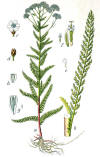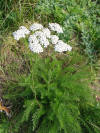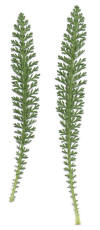WILD
FOODIES' HOME PAGE
PLANT PROFILE LIST
NAME: Yarrow
SPECIES / FAMILY: Achillea Millefolium / Asteraceae or Compositae
OTHER COMMON NAME(S):
CONDITIONS: sun
|
PARTS: |
EDIBLE |
TASTE |
RAW/COOK |
SEASON |
|
All |
|
|
|
|
|
Shoots |
|
|
|
|
|
Leaves |
|
bitter |
RAW/COOK |
Spring |
|
Stalk/Stem |
|
|
|
|
|
Buds |
||||
|
Flowers |
|
|
|
|
|
Fruits |
|
|
|
|
|
Pods |
|
|||
|
Seeds |
|
|
|
|
|
Nuts |
|
|
|
|
|
Roots |
|
|
|
|
|
Bark |
|
|
|
|
PORTION: small
COMMENT: Ferny and delicate looking. / “A rather bitter flavour, they make an acceptable addition to mixed salads... The leaves are also used as a hop-substitute for flavouring and as a preservative for beer etc. Although in general yarrow is a very nutritious and beneficial plant to add to the diet, some caution should be exercised. An aromatic tea is made from the flowers and leaves. An essential oil from the flowering heads is used as a flavouring for soft drinks.”(1)
CAUTION: “Extended use of this plant, either medicinally or in the diet, can cause allergic skin rashes or lead to photosensitivity in some people. Theoretically yarrow can enhance the sedative effects of other herbs (e.g. valerian, kava, German chamomile, hops) & sedative drugs. Possible sedative & diuretic effects from ingesting large amounts.”(1) Over several years, a build-up of its own toxins in the soil will hinder the herb's growth. Pregnant women should avoid yarrow, since large doses may cause abortion. (7)
NUTRITION/MEDICINAL:
It is known as the military herb...Besides
wounds and sores, yarrow has been used to treat a multitude of other problems,
including eruptive diseases like measles or poxes. Jethro Kloss wrote that,
"if taken freely at the beginning of a cold, with other simple remedies, it
will break it up in 24 hours." That is probably attributable to the herb's
competence at cooling fevers, increasing circulation, soothing aching muscles,
and healing mucous membranes.(7)
Yarrow has a high reputation and is widely employed in herbal medicine,
administered both internally and externally. It is used in the treatment of a
very wide range of disorders but is particularly valuable for treating wounds,
stopping the flow of blood, treating colds, fevers, kidney diseases, menstrual
pain etc. The whole plant is used, both fresh and dried, and is best harvested
when in flower. Some caution should be exercised in the use of this herb since
large or frequent doses taken over a long period may be potentially harmful,
causing allergic rashes and making the skin more sensitive to sunlight. The
herb combines well with Sambucus nigra flowers (Elder) and Mentha x piperita
vulgaris (Peppermint) for treating colds and influenza. The herb is
antiseptic, antispasmodic, mildly aromatic, astringent, carminative,
cholagogue, diaphoretic, digestive, emmenagogue, odontalgic, stimulant, bitter
tonic, vasodilator and vulnerary. It also contains the anti-inflammatory agent
azulene, though the content of this varies even between plants in the same
habitat. The herb is harvested in the summer when in flower and can be dried
for later use. The fresh leaf can be applied direct to an aching tooth in
order to relieve the pain.(1)
LOOK-A-LIKES:
POISONOUS LOOK-A-LIKES:
OTHER USES: The growing plant repels beetles, ants and flies. The plant has been burnt in order to ward off mosquitoes. A liquid plant feed can be made from the leaves. You fill a container with the leaves and then add some water. Leave it to soak for a week or two and then dilute the rather smelly dark liquid, perhaps 10 - 1 with water though this figure is not crucial. This plant is an essential ingredient of 'Quick Return' herbal compost activator. This is a dried and powdered mixture of several herbs that can be added to a compost heap in order to speed up bacterial activity and thus shorten the time needed to make the compost. The fragrant seeds have been used to impart a pleasant smell indoors. An essential oil obtained from the leaves is used medicinally. The leaves contain from 0.6 to 0.85% essential oil. The leaves have been used as a cosmetic cleanser for greasy skin. Yellow and green dyes are obtained from the flowers. A good ground cover plant, spreading quickly by its roots[208]. A dynamic accumulator gathering minerals or nutrients from the soil and storing them in a more bioavailable form - used as fertilizer or to improve mulch. Nectary, invertebrate shelter. (1)
SOURCE LINKS (may include nutritional and medicinal info, plus other uses):
- https://www.pfaf.org/user/Plant.aspx?LatinName=Achillea+millefolium
- https://en.wikipedia.org/wiki/Achillea_millefolium
- http://www.foragingtexas.com/2008/09/yarrow.html (good photos)
- http://www.ediblewildfood.com/common-yarrow.aspx (good photos)
- https://commons.wikimedia.org/wiki/Achillea_millefolium (good photos)
- https://www.thymewilltell.com/yarrow.html Staunch Yarrow: The Military Herb
- https://theherbalacademy.com/blog/yarrow Yarrow: The Plant That Made Achilles Invincible
- https://www.livingthroughnature.com/blog/yarrow-folklore-medicine-and-magic Yarrow: Folklore, Medicine and Magic
-
https://www.rowanandsage.com/blog/2019/12/6/plant-profile-yarrow - Yarrow: Myth, Magic, and Medicine


